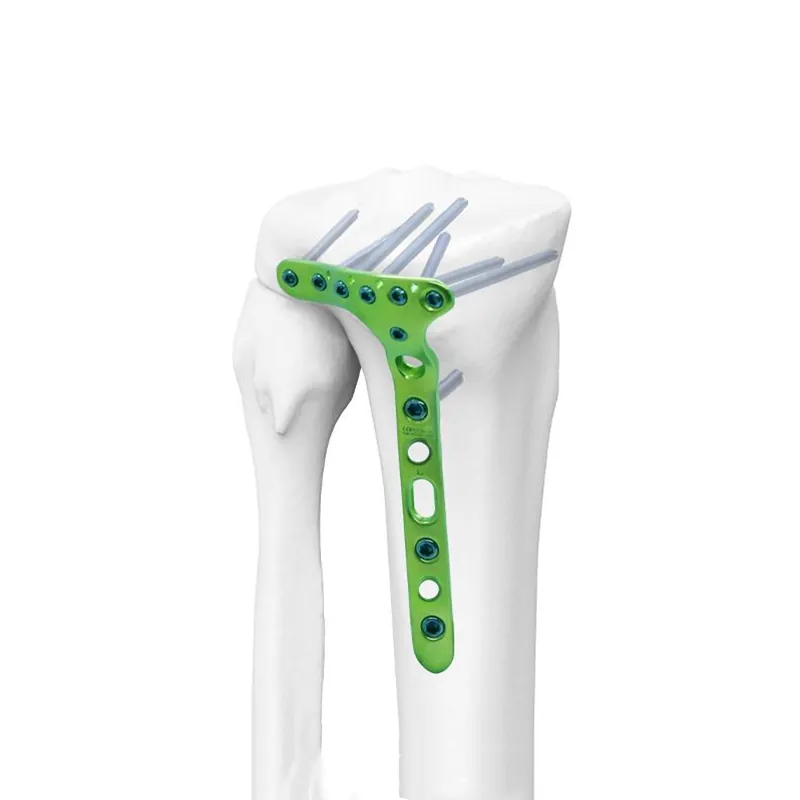Distal Lateral Tibial Locking Plate: A Comprehensive Guide
The distal lateral tibial locking plate is a medical device that is used in the fixation of fractures of the distal tibia. This device provides stable fixation of the fractured bone and allows for early mobilization of the patient. In this article, we will discuss the distal lateral tibial locking plate in detail, including its design, indications, surgical technique, complications, and outcomes.
1. Introduction
The distal lateral tibial locking plate is a type of plate that is used in the treatment of fractures of the distal tibia. This plate is designed to provide stable fixation of the bone fragments and allows for early mobilization of the patient. The plate is made of titanium and has multiple holes for the placement of screws.
2. Design
The distal lateral tibial locking plate has a unique design that allows for stable fixation of the distal tibia. The plate has a proximal end and a distal end, and it is contoured to fit the shape of the tibia. The plate has multiple screw holes, and the screws are inserted in a locking fashion. The locking mechanism of the screws prevents the screws from backing out and provides stable fixation of the bone fragments.
3. Indications
The distal lateral tibial locking plate is indicated for the treatment of fractures of the distal tibia. The plate is particularly useful in the treatment of fractures that are difficult to stabilize with traditional methods. This includes fractures that are comminuted or have multiple fragments. The plate is also useful in the treatment of fractures that are near the ankle joint.
4. Surgical Technique
The surgical technique for the distal lateral tibial locking plate involves an open reduction and internal fixation of the fractured bone fragments. The plate is contoured to fit the shape of the tibia and is positioned on the lateral aspect of the bone. The screws are inserted in a locking fashion, and the plate is secured to the bone.
5. Complications
Complications associated with the use of the distal lateral tibial locking plate include infection, nonunion, malunion, and hardware failure. Infection can occur at the site of the surgical incision or around the hardware. Nonunion and malunion can occur if the bone fragments do not heal properly. Hardware failure can occur if the screws or plate break or back out.
6. Outcomes
The use of the distal lateral tibial locking plate has been shown to be effective in the treatment of fractures of the distal tibia. The plate provides stable fixation of the bone fragments and allows for early mobilization of the patient. Studies have shown that the use of the plate results in high rates of union and good clinical outcomes.
7. Conclusion
The distal lateral tibial locking plate is a useful device in the treatment of fractures of the distal tibia. The plate provides stable fixation of the bone fragments and allows for early mobilization of the patient. However, the device is associated with a risk of complications, and careful patient selection and surgical technique are important for optimal outcomes.
FAQs
What is a distal lateral tibial locking plate? A distal lateral tibial locking plate is a medical device that is used in the fixation of fractures of the distal tibia.
How does a distal lateral tibial locking plate work? A distal lateral tibial locking plate provides stable fixation of the fractured bone and allows for early mobilization of the patient. The plate is made of titanium and has multiple holes for the placement of screws.
What are the indications for a distal lateral tibial locking plate? The distal lateral tibial locking plate is indicated for the treatment of fractures of the distal tibia. It is particularly useful for fractures that are difficult to stabilize with traditional methods, such as comminuted fractures or fractures near the ankle joint.
What are the potential complications of using a distal lateral tibial locking plate? Complications associated with the use of the distal lateral tibial locking plate include infection, nonunion, malunion, and hardware failure. Careful patient selection and surgical technique are important for optimal outcomes.
What are the outcomes of using a distal lateral tibial locking plate? Studies have shown that the use of the distal lateral tibial locking plate results in high rates of union and good clinical outcomes. However, individual outcomes may vary depending on the specific patient and fracture characteristics.
English
Français
Русский
Español
العربية
Português
Deutsch
italiano
日本語
한국어
Nederlands
Tiếng Việt
ไทย
Polski
Türkçe
አማርኛ
ພາສາລາວ
ភាសាខ្មែរ
Bahasa Melayu
ဗမာစာ
தமிழ்
Filipino
Bahasa Indonesia
magyar
Română
Čeština
Монгол
қазақ
Српски
हिन्दी
فارسی
Kiswahili
Slovenčina
Slovenščina
Norsk
Svenska
українська
Ελληνικά
Suomi
Հայերեն
עברית
Latine
Dansk
اردو
Shqip
বাংলা
Hrvatski
Afrikaans
Gaeilge
Eesti keel
Māori
नेपाली
Oʻzbekcha
latviešu
অসমীয়া
Aymara
Azərbaycan dili
Bamanankan
Euskara
Беларуская мова
भोजपुरी
Bosanski
Български
Català
Cebuano
Corsu
ދިވެހި
डोग्रिड ने दी
Esperanto
Eʋegbe
Frysk
Galego
ქართული
guarani
ગુજરાતી
Kreyòl ayisyen
Hausa
ʻŌlelo Hawaiʻi
Hmoob
íslenska
Igbo
Ilocano
Basa Jawa
ಕನ್ನಡ
Kinyarwanda
गोंगेन हें नांव
Krio we dɛn kɔl Krio
Kurdî
Kurdî
Кыргызча
Lingala
Lietuvių
Oluganda
Lëtzebuergesch
Македонски
मैथिली
Malagasy
മലയാളം
Malti
मराठी
ꯃꯦꯇꯥꯏ (ꯃꯅꯤꯄꯨꯔꯤ) ꯴.
Mizo tawng
Chichewa
ଓଡ଼ିଆ
Afaan Oromoo
پښتو
ਪੰਜਾਬੀ
Runasimi
Gagana Samoa
संस्कृत
Gaelo Albannach
Sepeti
Sesotho
chiShona
سنڌي
Soomaali
Basa Sunda
Wikang Tagalog
Тоҷикӣ
Татарча
తెలుగు
ትግንያውያን
Xitsonga
Türkmençe
संस्कृत
ئۇيغۇرچە
Cymraeg
isiXhosa
ייִדיש
Yorùbá
isiZulu








































